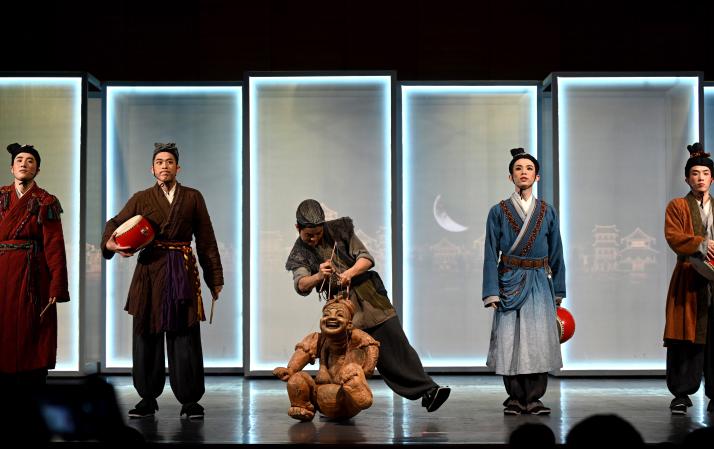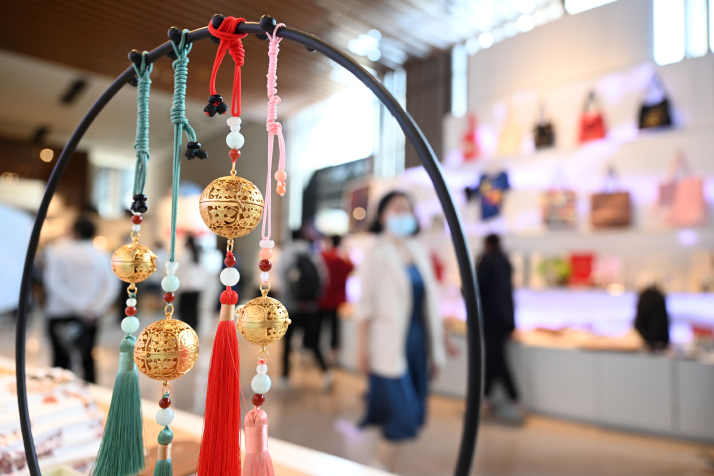The Right Tone

A performance of the National Museum of China's (NMC's) stage play Joyful Songs in a Flourishing Age in Beijing on May 27 (XINHUA)
In May, the National Museum of China (NMC) launched its first original stage play, Joyful Songs in a Flourishing Age, as part of a project seeking to revitalize cultural heritage.
Inspired by the Pottery Storyteller Beating a Drum, a piece in the NMC's collection from the Eastern Han Dynasty (25-220), the play presented a fantasy "dialogue" between the ancient ceramic figure and the audience while integrating art forms such as drama, musical, opera, dance and poetry.
Dialogues across time and space are happening in new ways at the NMC.
The bronze exhibits from the Xia, Shang and Zhou dynasties (ca. 2070-256 B.C.) displayed inside the NMC's Ancient China exhibition hall often lead visitors to marvel at the grandeur of ancient Chinese civilization.
To assess the overall condition of a yi, a bronze wine vessel from the Shang, NMC researchers used X-ray imaging to analyze its historical restoration during studies in recent years. They were then able to determine the chemical composition of the repair materials used, laying a scientific basis for further protection.
The museum today employs a team of experts in researching, protecting, restoring and reproducing cultural relics. The team protects the artifacts applying both well-honed skills and advanced technologies.
The NMC's cultural and creative products, such as chocolates and incense burners shaped like the Four-Goat Square Zun (wine vessel) from the Shang and the Haiyan Heqing Zun from the Qing Dynasty (1644-1911), all radiate the fun of immersive archaeology.
The goat was considered an auspicious animal in ancient China and haiyan heqing, which literally translates as "seas and rivers are peaceful and clear," refers to peace on Earth.
Collectible cards featuring images of the museum's collections have also proven quite popular with visitors.

An artifact repairer shows visitors how modern technology is applied in the restoration of an ancient architectural model at the NMC on May 16 (XINHUA)
"The rich cultural heritage of a museum can move people," Zhu Xiaoyun, Deputy Director of the NMC's Sales and Development Department, said. "Cultural and creative products can bridge gaps (between past and present) and help visitors better relate to hidden cultural meanings."
A kaleidoscope of creative products themed on the artifacts on display at the museum helps connect the NMC with the public, kindle cultural memories and spread Chinese stories.
The continuous development of China's public cultural undertakings has inspired museums to meet increasingly diversified and individualized needs in social education. "Every citizen in modern society must possess some level of scientific and cultural knowledge," Wang Chunfa, Director of the NMC, said. "Schools are the main contributors to this field, but off-campus education is also gaining momentum, echoing the popular concept of lifelong learning. Museums have become an important channel for off-campus education."

Traditional handmade accessories created by the NMC on display on May 18 (XINHUA)
Previously, a museum guide was a central facet of the NMC visitor experience. Today, the museum has created a social education program integrating face-to-face explanations, a smart tour guide system, museum-school cooperation and volunteers. The NMC is performing like a university, seeking to impart knowledge and inspire wisdom through history.
Since 2018, the NMC has been moving toward the construction of a smart museum via cutting-edge information technologies. It has developed virtual exhibition halls and published short videos on its social media platforms. Visitors can enjoy exhibitions online, with millions getting a taste of Chinese culture without even leaving their homes.
In 2022, the NMC partnered with 33 museums, located both within and outside China's borders, to launch the Treasure Hunt Relay: Global Museum Director's Choice program. The NMC's special exhibition under the program presented visitors with an immersive experience thanks to digital technology and a high-definition presentation, allowing them to understand the importance of Chinese characters in Chinese civilization across more than 5,000 years as well as the exchange and mutual learning among world civilizations.